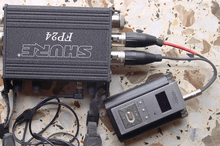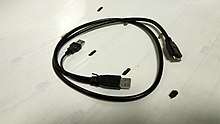Y-cable
A Y-cable, Y cable, or splitter cable is a cable with three ends: one common end and two other ends. The Y-cable can resemble the Latin letter "Y".

Uses
Analog audio/video signals
There are five common uses for Y-cables in signal paths:
- combining signals (feeding two outputs to one input);[1]
- splitting signals (feeding one output to two inputs);[2][3]
- consolidating connectors (feeding signals from two output connectors to a multi-pole input connector, keeping the signals separate);[4]
- un-consolidating connectors (feeding signals from one multi-pole output connector to two input connectors, keeping the signals separate);[5][6][7]
- send and return (outbound signal on one leg of the "Y"; inbound signal on the other; signals kept separate).[8][9]
A Y-cable common in domestic settings has a stereo 3.5mm (1/8″) stereo male minijack at one end, to plug into the line- or headphone-output of an MP3 player, mobile phone, or computer soundcard, and a pair of RCA (phono) male plugs to connect to the left and right mono inputs of an external amplifier. This is an example of un-consolidating connectors, as described above.
Power
Mains
Y-shaped mains leads enable two appliances to run from one mains plug.
Internal disk drives
In older desktop PCs, PATA (aka "IDE") devices such as 5.25 inch optical drives and 3.5 inch hard drives are typically powered by means of AMP MATE-N-LOCK Y-cables.[10]
USB
Traditional USB Y-cables exist to enable one USB peripheral device to receive power from two USB host sockets at once, while only transceiving data with one of those sockets. As long as the host has two available USB sockets, this enables a peripheral that requires more power than one USB port can supply (but not more than two ports can supply) to be used without requiring a mains adaptor. Portable hard disk drives[11][12] and optical disc drives[13][14] are sometimes supplied with such Y-cables, for this reason.
A newer variant on this kind of cable allows a USB peripheral to receive data and power from two different devices respectively. This allows power-hungry peripherals to be used with sockets that are designed to supply little or no outgoing power, such as USB On-The-Go mini-B sockets on smartphones. The power is supplied to the third leg of the "Y" by a mains adaptor or a power bank.
References
- Tingen, Paul (November 2011). "Tom Syrowski: Recording Incubus' 'Adolescents'". Sound on Sound.
I had a [Sennheiser] 421 [microphone] on the top and [a Shure] SM57 [microphone] on the bottom of each of the toms, going into the console via a Y-cable, so the signals from the 421 and the 57 were blended in the cable and came up under one fader on the console. For some reason that works and sounds really good.
- Robjohns, Hugh (May 2017). "How best can I split a mic signal?". Sound on Sound.
[If] you were to split the mic signal with a simple Y-cord the mic would indeed ‘see’ the two input destinations effectively in parallel with each other, and that will result in the effective load for the microphone being reduced below the impedance of either. [Transformerless] capacitor and active-dynamic mics won’t have a problem at all [but] if the impedance gets too low, you might possibly notice a small change in the tonal character or transient response with traditional dynamic mics and transformer-output capacitor mics. [So a] simple Y-cord (parallel split) can certainly work, and I’ve used that technique myself on occasion, but it does open the door to conflicting phantom-power supply problems, and makes ground loops very likely. The way around the ground-loop issue — this applies to active splitter/preamp techniques too, of course — is to disconnect and isolate the cable screens for all but one of the outputs at the destinations. Balanced connections don’t employ the cable screen as a ground reference, so disconnecting it won’t affect the signal transfer (but it is required for the return phantom current, so needs to be present in the connection to the preamp providing phantom power).
- Robjohns, Hugh (December 2003). "How do I create a stereo mix from mono material?". Sound on Sound.
You now need to derive two outputs from this ... signal [which can be done using] a splitter cable ...
- Margetts, Anna; Margetts, Andrew (2012). "Chapter 2: Audio and Video Recording Techniques for Linguistic Research". In Thieberger, Nicholas (ed.). The Oxford Handbook of Linguistic Fieldwork. Oxford University Press. ISBN 9780199571888.
We recommend taking a simple microphone splitter jack which allows two mono microphones to record simultaneously into [each of] the two channels of a typical stereo jack input. [This] can be used effectively with ... an MP3 recorder with a couple of basic wired lapel microphones.
N.B. A splitter jack is electrically equivalent to a Y-cable, just in a rigid enclosure instead of having flexible parts. - Walker, Martin (November 2002). "Testing & Improving PC Soundcard Audio Performance". Sound on Sound.
Consumer soundcards generally use 3.5mm stereo 'mini' jack sockets, which although somewhat less robust than their quarter-inch relations, take up significantly less space on the backplate. If you have such a card, you'll need to buy or solder up stereo-to-twin-mono leads to connect to most music gear.
- Robjohns, Hugh (January 2013). "Lewitt Audio DTP640 REX". Sound on Sound.
A 1.5m Y-cable is supplied with the mic ... to convert the five-pin connection into two standard three-pin XLR connectors, each with labelled cable sleeves to identify which provides the dynamic element signal, and which the capacitor element.
Missing or empty|url=(help) - Ragusea, Adam (2016-07-06). "A DIY method for recording a live podcast or radio show". Current.
To get the sound from the iPhone to the Zoom, you need a slightly unusual kind of patch cable called a “stereo breakout” cable or “Y splitter” that will split the stereo output of the phone into two separate mono channels (remember, each of the inputs on the Zoom is strictly mono). I use a Hosa 3.5mm TRS (stereo mini plug) to dual 1/4”... The mini plug goes into the iPhone’s headphone jack, and the two 1/4″ plugs go into the inputs on the Zoom’s expander module...
- Robjohns, Hugh; White, Paul (December 2006). "Studio SOS: Ross Prior". Sound on Sound.
The type of mixer found in project studios almost always has unbalanced insert points, which are accessed though the same TRS jacks normally used in balanced cables. However, these are wired such that they carry both the (unbalanced) send and return signals down the two inner cores, using the outer screen as a common signal ground. At the outboard (or patchbay) end, the lead is broken out into two tip-sleeve plugs, one carrying the send signal and the other the return (hence the popular term 'Y-cable'). Normally, the Tip contact is used as the send from the mixer, and the Ring carries the return, although this isn't always the case, so you should check your mixer manual.
- Robjohns, Hugh; White, Paul (December 2015). "Should mixer insert connections be balanced or unbalanced?". Sound on Sound.
Many mixers offer unbalanced insert points as it’s convenient to use a [single] TRS jack to handle both the send and return signal.
- Webopedia Computer Dictionary - What is Y-Cable?
- Jackson, Jerry (2010-07-07). "Iomega eGo USB 3.0 Portable Hard Drive Review". TechTarget.
Iomega previously included a “Y” cable for connecting the eGo Portable Hard Drive to older notebooks or budget netbooks that might require two USB 2.0 connections in order to power an external hard drive. The new USB 3.0 drive takes advantage of the higher power output of the USB 3.0 port and comes with a single USB cable that is easier to pack in your laptop case.
- "Lenovo ThinkPad USB 3.0 Secure Hard Drive". Ziff Davis. 2012-06-19.
The ThinkPad Secure Hard Drive ... comes with a ... Y cable that connects the drive to two USB 2.0 ports for adequate power if your PC doesn't have a USB 3.0 port.
- Purdy, Kevin; Streams, Kimber (3 October 2017). "The Best External Optical Drives for DVDs and Blu-rays". The New York Times Company.
[The] Pioneer BDR-XD05B ... comes with a USB 3.0 Y-cable, which is handy for older computers that can’t power the drive from one port.
- Kazi, Ahmer. "HP bd530s". Ziff Davis.
As is often the case with portable optical drives, a USB Y-cable is included for plugging into the micro-USB port on the rear of the drive. Since the [HP] bd530s is bus-powered, there's no need for an extra AC adapter. While the thirty six inch primary strand of the Y-cable is generously sized, the ancillary strand is a paltry sixteen inches long, which may not be long enough to reach a USB port on the other side of a laptop. While it's worth noting, this is an admittedly minor gripe...
